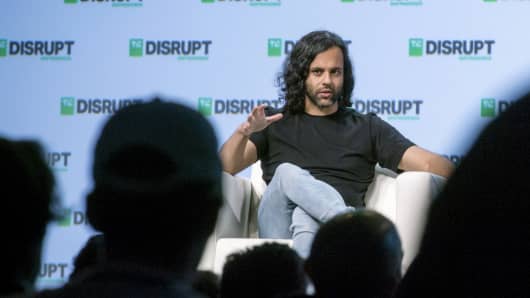Robinhood is going back to the drawing board.
Just a day after unveiling what it called checking and savings accounts, the financial technology startup said it is re-launching and re-naming the product, which came under immediate scrutiny from Wall Street and federal officials about potentially misleading investors.
In a blog post released late Friday evening, Robinhood’s founders acknowledged that its new plan, which aimed to offer no-fee checking and savings accounts “may have caused some confusion.”
The plan was announced with great fanfare on Thursday, but drew questions about whether the program could adequately protect investor money. Robinhood said it would offer checking and savings accounts with an industry-leading 3 percent interest rate and no fees or account minimums. The free product builds off the company’s no-fee stock-trading model that ushered in 6 million users and a $5.6 billion valuation in its five-year existence.
Following the announcement, Bloomberg first reported that the Securities Investor Protection Corp’s top official had concerns about the program and insisted Robinhood never called him before launching the program.
As a result, “we plan to work closely with regulators as we prepare to launch our cash management program, and we’re revamping our marketing materials, including the name,” wrote Baiju Bhatt and Vlad Tenev, the start-up’s co-founders and Co-CEOs.
Stephen Harbeck, head of SIPC, told CNBC in a phone interview Friday that he was just as surprised as anyone to hear about Robinhood’s plan. He confirmed that the start-up did not contact his office ahead of the product launch, and to his knowledge Robinhood had not contacted the SEC, either.
“I have serious concerns over what they’ve done, and they took no action to alleviate my concerns,” Harbeck told CNBC, adding that he had contacted the SEC’s trading and markets division about it.
‘There needs to be certainty’
A key issue for Harbeck was the purpose of these accounts.
Robinhood’s brokerage accounts are covered by SIPC insurance, which protects up to $250,000 of cash in the case of a broker’s failure. But there is a big distinction from bank accounts, which are covered by FDIC insurance.
Brokerage accounts are meant for customers to hold cash until it can be invested in securities, and those accounts aren’t meant to be strictly for savings, Harbeck said. Money sitting in such accounts, but not intended to buy securities, may not be covered by the SIPC. The agency insures accounts for up to $250,000 of cash, in the case of a broker’s failure.
The issue also caught the attention of former lawmakers and Wall Street.
Former Rep. Barney Frank, a key architect of the post-crisis financial reform that bears his name, raised flags about certain aspects of the new Robinhood product. He said SIPC insurance is overall, “less comprehensive” than FDIC insurance.
“If there’s any uncertainty about regulatory protection, there is serious potential for people to be misled,” Frank told CNBC in a phone interview. “There needs to be certainty — if there’s stuff that isn’t covered it needs to be in big bold [letters] on the top of the page.”
UBS analyst Brennan Hawken explained to clients that Robinhood’s product was designed to look like a bank. But that’s part of the problem.
“The fine print of the website says the offering is NOT a bank account, so the regulatory oversight of this offering is likely more thin,” Hawken said in a research noteFriday, adding that bank regulators would likely want to know more about anti-money laundering safeguards in place and capital levels.
“There’s a risk that bank regulators could take issue with an entity with 3 million accounts presenting itself as offering banking products but avoiding the regulatory scrutiny that would go along with it,” Hawken said.
[“source=cnbc”]




